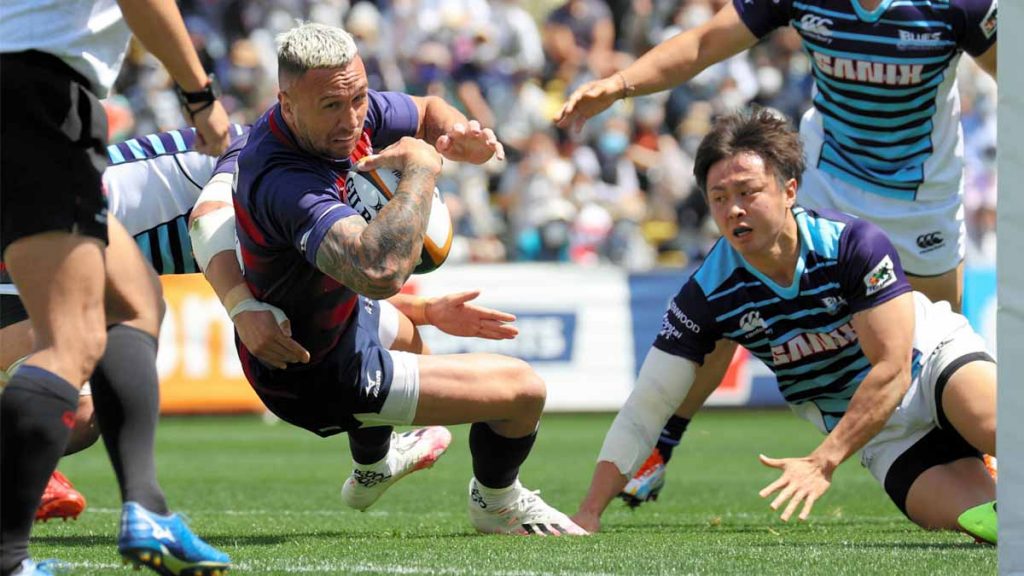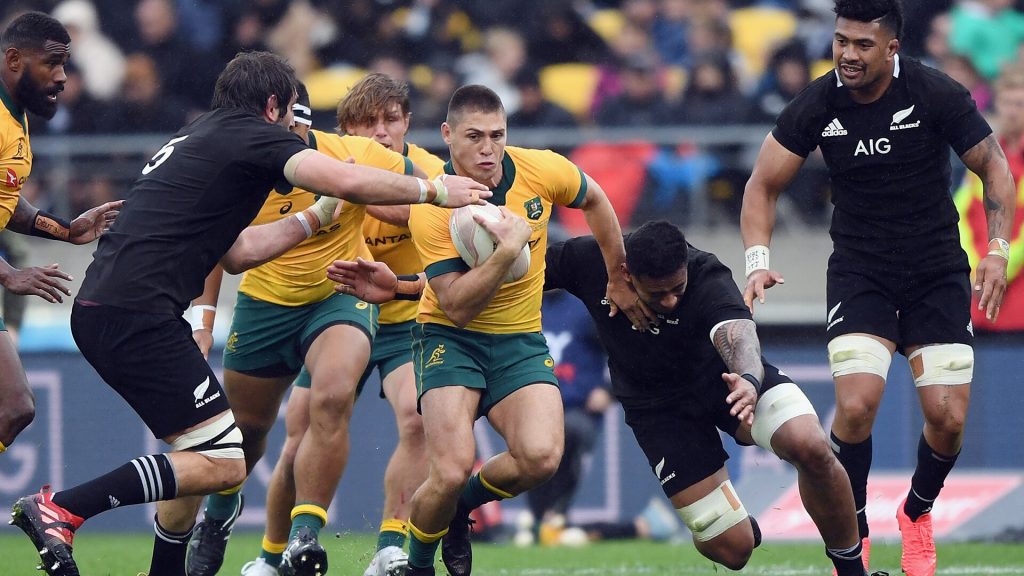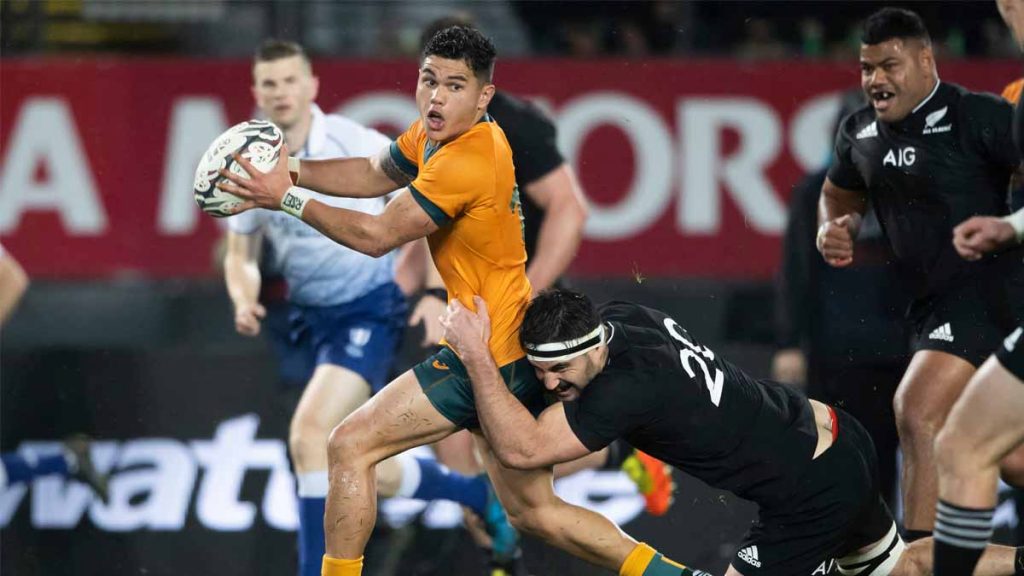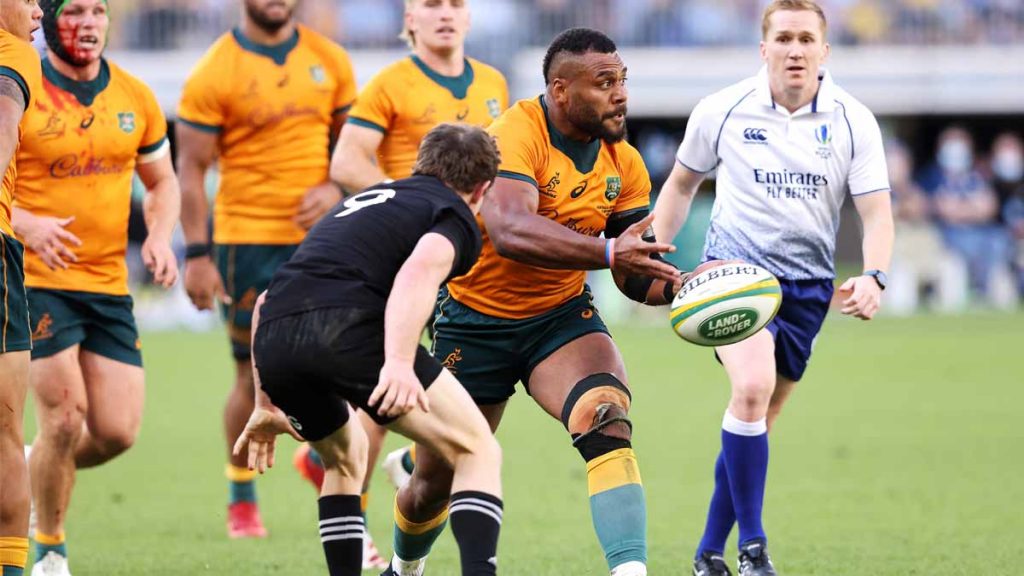They say a week’s a long time in politics, well the same can be said about Australian rugby.
Ahead of the first Springboks test, Dave Rennie smashed the emergency glass and re-ignited an international career most felt dead.
Quade Cooper’s selection at fly-half – a 33-year-old, who had not played test rugby since coming off the bench against Italy in 2017 – to face the world champions appeared a Hail Mary, with 21-year-old Noah Lolesio dropped.
This was a script seen before.
When the going went tough, three, and now four, Wallabies coaches had been wooed by a playmaker, who in his pomp, had a bag of tricks no Australian could match for skill and panache.

Now, off the back of a trio of Bledisloe defeats, Rennie, desperate to improve his own winning percentage in his second year in charge, turned to the 2011 Super Rugby champion who, for the last two years, has been working his magic and rebuilding his body in the Japanese Top League.
He hadn’t even played a game since April, if you don’t count the 60-minute match against a second-string Western Force side.
Rennie faced an interrogation of sorts on Friday, September 10, as he answered every question from Australia’s media, who had put the heat on the New Zealand coach.
“There’s certainly no panic,” he said.
A stop-gap with the World Cup two years away?
So impressive that Cooper, who really had not shown anything on the international stage since before the 2011 World Cup, stood up in the most understated and composed performance of his career as he saw the Wallabies to an after-the-siren 28-26 victory over the world champions.
“He could be,” Rennie said, smartly not putting a date on anything.
“Obviously James O’Connor’s not too far away from a return. “We’re just picking what we think is best for the time and like I said, Quade’s been really impressive.”
So impressive that Cooper, who really had not shown anything on the international stage since before the 2011 World Cup, stood up in the most understated and composed performance of his career as he saw the Wallabies to an after-the-siren 28-26 victory over the world champions.
Immediately the focus turned to how long could Cooper play on for.
France, 2023?
“Of course he could,” Rennie said. “We’re not thinking too far ahead at this stage and neither is he.

“He was excited to get an opportunity and he delivered big time, so a fantastic night for him and we’ll reassess and see how things go. I know he’s keen and available for the rest of the year and we’ll make a call beyond that.”
Cooper’s sensational return has changed the makeup of the Wallabies’ backline considerably.
Now there is not even room for O’Connor, who was recently re-signed by Rugby Australia on a lucrative deal to likely spearhead the Wallabies’ campaign to France, while also nurturing the burgeoning talent of Lolesio.
Ahead of selection for the second Springboks Test, two former Wallabies stars Chris Latham and Elton Flatley called for O’Connor to be included alongside Cooper and return to the position he announced his arrival at in international rugby in 2008: fullback.
He made the Boks sit back and watch and look because they just didn’t know what he was going to do, but he still played very well within the structure whilst doing that.
Former Wallabies fullback Chris Latham on Quade Cooper
“We know James is a world-class player when fit, so if he’s fit and ready to get out there, like Quade he’s got that experience and he’s got the know-how to play test rugby,” Flatley told The XV. “He’d go out and definitely do a job in the 15 jersey.
“There’s definitely opportunities for both of them [Cooper and O’Connor] to play in the same team.”
Latham, a former Queensland fullback who played 78 Tests for the Wallabies, said O’Connor’s skill-set alongside Cooper and the direct-running Samu Kerevi would give Rennie a backline to challenge any in the world.
“You need those players that can play unpredictable rugby within the structure. I thought that was the difference that Quade brought,” Latham said.
“He made the Boks sit back and watch and look because they just didn’t know what he was going to do, but he still played very well within the structure whilst doing that.
“Having O’Connor, another strike weapon out there, Samu with that direct running and ability to offload, and that ability to ball play as well, that mix will just make the Boks think ‘If we rush, we’re going to get hurt, so we have to wait’, and then you get that indecision, and that’s where opportunities start.”

The man most at risk of losing his place? 18-test outside back, Tom Banks.
The 27-year-old Brumbies fullback has been retained in the No 15 jersey but has yet to nail down the position and failed to play with the same conviction he has played with at Super Rugby level.
A player whose game is built around explosive running, a thumping right boot, particularly when kicking for touch, and a safe pair of hands, Banks is not a ball-playing fullback like Willie le Roux or Kurtley Beale for that matter. So when he doesn’t own his strengths, it begs the question of what he is doing there in the first place.
Eventually, Rennie hopes Jordan Petaia – the young Reds star, who wore the No 13 jersey against England in the World Cup quarter-final loss as a 19-year-old – will develop into a fullback, while Andrew Kellaway, who has taken to international rugby like a duck to water, also harbours wearing the No 15 jersey.
When announcing his side to take on the Boks in Brisbane, Rennie said he wanted to “reward the guys” who got the job done in their first encounter.
But he also admitted O’Connor, who has been plagued by injuries over the past half-a-decade was now hitting speeds to not just make him a quarterback, but a three-pronged threat.
“This is the best I’ve seen James,” he said. “Even through Super Rugby, he never did a lot of high-speed metres. We want him to be able to be a genuine threat at 10 if space opens up that he can attack and he ended up injuring a groin in preparation for the French series.
“He’s worked extremely hard and looks extremely sharp. He’ll be a strong contender next week.”
But where?
“We feel we could definitely play those guys [Cooper and O’Connor] in the same 23,” Rennie said.
“To have someone like James come back into the fold would be gold for us.”

Probed further, Rennie revealed he would now be thought of in a position outside first five, given his improved speed.
“We would definitely not have played him as a fullback a couple of months ago and prior to that because from a high-speed running perspective, he just hasn’t hit any decent numbers for the last couple of years,” Rennie said.
“But he’s worked really hard and he’s the sharpest I’ve seen him.
“He’s definitely into the physical shape where we think we could use him as a utility as opposed to just a 10.”
The luxury of spending time with James, spending time with Quade, and you’ve got to remember that Noah’s played a lot of rugby this year with a young 9, a young 12, a young 13, so he hasn’t had an enormous amount of experience around him.
Wallabies coach Dave Rennie
So where does that leave Lolesio, who started the first six tests of the year in the absence of O’Connor and led the Wallabies to an important series victory over France in July?
“We’ll reflect on that,” Rennie said. “To Noah’s credit, he had a really good training week so far.
“The luxury of spending time with James, spending time with Quade, and you’ve got to remember that Noah’s played a lot of rugby this year with a young 9, a young 12, a young 13, so he hasn’t had an enormous amount of experience around him.
“He’s an impressive young man, who is very dedicated and working hard on his game and he would have learnt a lot from the last part and he would have learnt a fair bit about watching Quade play on the weekend, so his game-management, it’s growing.
“We’ll see how this weekend goes and that’ll give us more of an indication on where Noah’s at and James is at.”

The makeup of the Wallabies’ playmakers is far from settled, but a position that not long ago appeared razor-thin has almost overnight revealed three genuine options.
Former Wallabies playmaker Elton Flatley, who played inside centre during Australia’s run to the World Cup final in 2003, has known Lolesio for the best part of a decade.
Flatley’s son attended the same Southport School on the Gold Coast and said Lolesio’s dedication and work-ethic held him in good stead, and he believed the young pivot would play a big role for the Wallabies going forward.
“It’s actually a real positive to have Quade back,” Flatley told The XV.
It’s not an easy position to play as a young man and direct traffic to guys who are sometimes 10 years older than you.
Former Wallabies playmaker Elton Flatley
“He’ll learn a lot from Quade about how to be an international No 10, so I think that’s a real positive and he’ll go on tour and tour the UK and Quade mightn’t necessarily play all those tests and there will be injuries. He’ll be with the squad all the way through.
“As I did, you learn and grow. It’s not an easy position to play as a young man and direct traffic to guys who are sometimes 10 years older than you.
“In patches, he’s done a really good job and his learning curve is just going to get better and better. With a few more years of international rugby whether it’s in the squad or on the bench, he’ll be poised to play a big part in the World Cup in 2023.”
While the crucial No 10 jersey has dominated the discourse for a decade in Australian rugby, Samu Kerevi’s stunning return has changed the way the Wallabies can attack.
Just like when Manu Tuilagi is fit for England, or Ma’a Nonu previously with the All Blacks, Kerevi’s ability to straighten the attack and bend the gain line allows the Wallabies to attack from halfback, first five and play out the back – something that has hurt Rennie’s side in 2021, with multiple intercepts resulting.

The Wallabies are benefitting from the relaxing of eligibility law, which has allowed Kerevi to play despite previously being ineligible given he had not met the 60-cap, seven-year threshold required for overseas-based players.
Nor is Kerevi the only shining light, with Tate McDermott’s running threat and the composure and nous shown by Kellaway real finds in 2021.
The view that the season appeared to be spiralling out of control against the All Blacks was short-sighted. It was reactionary.
As Steve Hansen told The XV this week, “I’ve never been in doubt about the players that Australian rugby has, I think they’ve got some wonderful, wonderful players.”
The strength of Australian rugby is seen in the players left on the sidelines at present; O’Connor, centre Hunter Paisami and backrower Harry Wilson.
A week is a long time in rugby.
Now the Wallabies must brace for a Springboks retaliation.


Comments
Join free and tell us what you really think!
Sign up for free